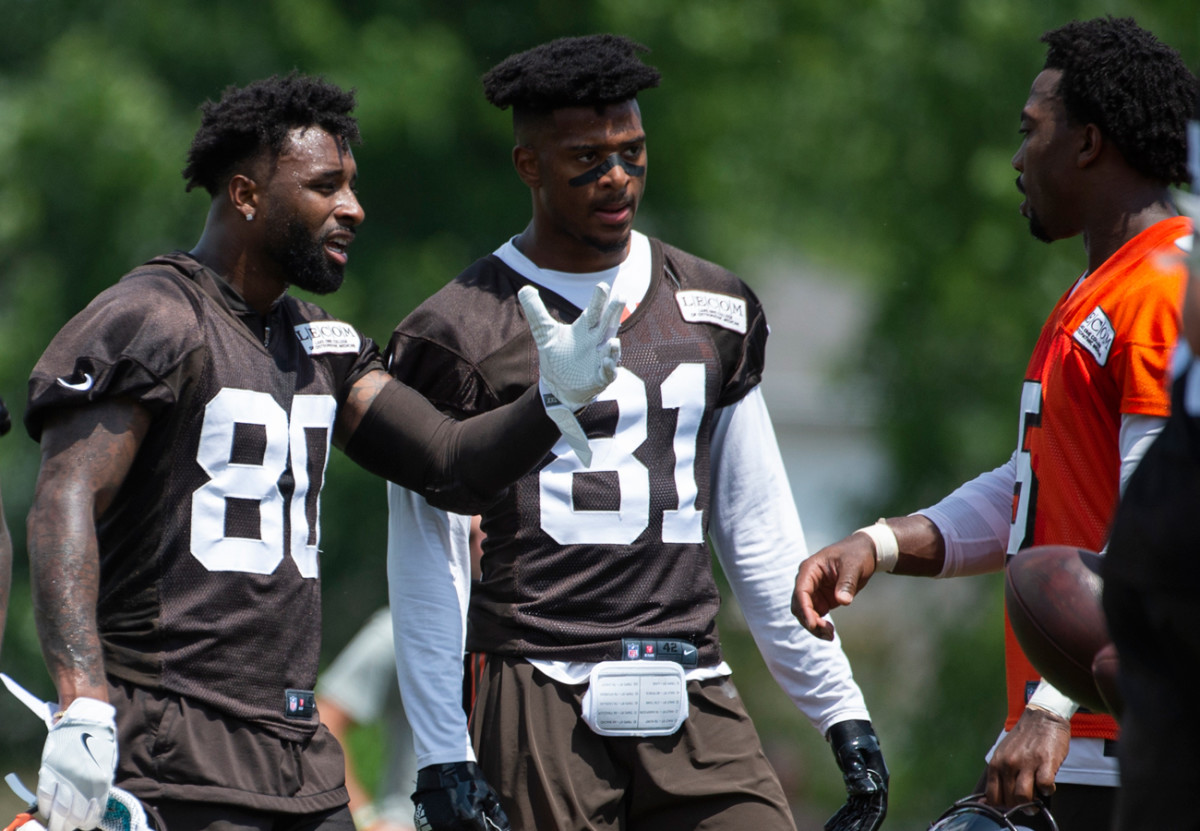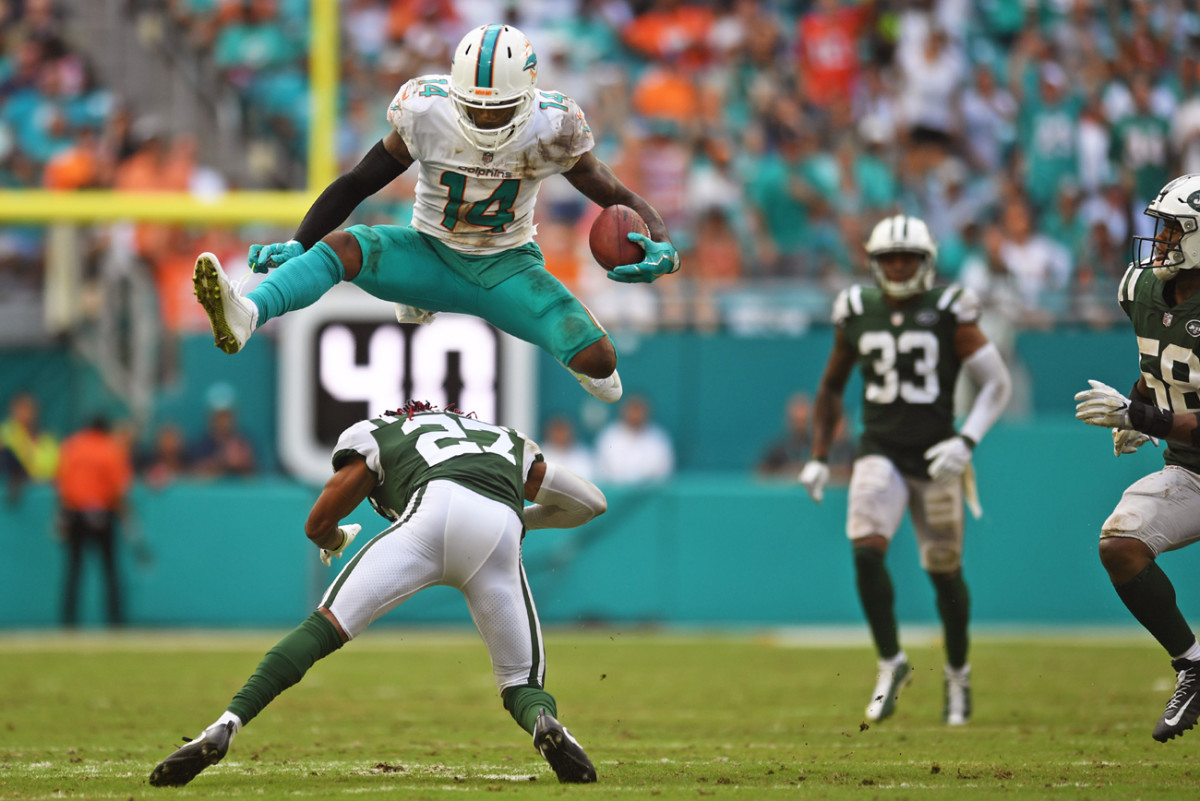Browns Bet Big on the Slot With Jarvis Landry

Watch 24 Hours With ... Jarvis Landry exclusively on SI TV, with a free seven-day trial.
This story appears in the July 20, 2018, issue of Sports Illustrated. For more great storytelling and in-depth analysis, subscribe to the magazine—and get up to 94 percent off the cover price. Click here for more.
Jarvis Landry stands in front of a black-and-gold marble wall inscribed with the signatures of those who have attained in their profession what he has been fighting for in his. Acknowledgment. Respect. Appreciation. A legacy and a place in history.
He reads the names to himself. James Brown. The Beatles. Stevie Wonder. Tupac.
It is late April, on the third floor of the Rock & Roll Hall of Fame in Cleveland, the city Landry is in the process of making his home. He asks a tour guide if an artist needs a majority vote or a unanimous one to be enshrined in the Hall. Who decides? What does it take to get in? Landry searches in vain for the signatures of some artists. He’s told they have yet to be enshrined. “Everyone gets their turn,” Landry says, his tone hopeful.
There’s no consensus about the value Landry brings to an NFL team, even though he is widely believed to be the best in the league at what he does. His position is oft-derided; the term slot receiver hangs like a pall over him. Through four seasons in the NFL he has 400 receptions, more than anyone before him in the history of the league, but still the Dolphins didn’t appreciate him. Not the way he wanted them to, at least.
Landry continues up escalators, down hallways, taking in all of the exhibits. He makes special note of the attire on display—Hendrix’s gold dashiki, Elvis’s bedazzled suit. He says he plans to come back every week, take pictures of a different outfit and have a custom version made for game day. For Week 1 at Pittsburgh he has already chosen Rob Zombie’s black-and-silver, full-length, metallic-leather jacket, with long tassels hanging from the sleeves, leather fringe and metal grommets. Even if you don’t consider Landry a star—and Miami didn’t—he can damn sure dress like one.

During contract negotiations last season the Dolphins refused to pay the 5' 11", 196-pound Landry as if he was one of the top receivers in the league, believing that his production is illusory—that despite all the grabs, his low yardage per catch (10.1) and touchdown average (5.5) over his career hadn’t helped contribute to wins. (Their best offer, Landry says, was $55 million over five years, with $27 million guaranteed.) So the team set their most popular player out, in Landry’s view, like an item in a yard sale, and in March the Browns picked him up for two piddling late-round picks.
“I was hurt by it,” Landry says. “I became the face of the franchise in Miami, and I don’t think they wanted me to be that. The respect was just never there.”
The Browns, however, promptly gave him the contract he was seeking: $75.5 million over five years, $47 million guaranteed, equaling the third-highest payout for a receiver in NFL history. Not for a slot receiver—for any receiver. The “thousand voices,” as Landry calls his detractors, treated the move harshly. A sampling of headlines: THE BROWNS COMPLETELY OVERPAID JARVIS LANDRY; NO ONE IS AFRAID OF JARVIS LANDRY; SLOT RECEIVER JARVIS LANDRY ISN’T A GAME CHANGER.
You’d think the 25-year-old Landry would be used to it by now, the disconnect between his production on the field and the lack of love he feels from teams. He still remembers the pain he felt on draft day, 2014. Did I do something wrong? he wondered aloud, as he waited 63 picks to hear his name called, long past his agent’s optimistic prediction, after 11 other receivers had gone. (His LSU classmate and best friend, Odell Beckham Jr., went No. 12 to the Giants, even though Landry had more catches, yards and touchdowns in their junior—and final—season.) By the time Landry was picked, the cheeks of all 50 family members and friends, all crowded into the Baton Rouge hotel room he had rented, were stained with tears, none more than his own.
Will Baker Mayfield Take Over the Starting Job in Cleveland? 10 Thoughts on the 2018 Browns
Landry channels this same sense of aggrievement every time he takes the field; it drives him through another tackle, propels him to another first down. The old heads in the Convent, La., neighborhood where he grew up told football war stories, of crackback blocks and over-the-middle catches, instilling the idea that toughness and tenacity supersede all. It’s why Landry, as an eight-year-old, would sprint up the levee near his one-room trailer-park home, sitting right on a bank of the Mississippi, every day before dawn. Why he would break into LSU’s training facility at 3 a.m., using a credit card to jimmy open a back door, and catch 300 balls from the JUGS machine by himself. It’s why he used to steal his older brother’s shoes, not just for style, but because the ensuing beating he’d take helped inure him to pain.
All he has ever wanted is success as a football player; it consumes him. Landry calls this drive his greatest strength, but it’s also his greatest weakness; he’s been labeled a hothead, a malcontent, his passion misconstrued. The thought of failure terrifies him. Now, on a team that has won a single game over the last two seasons, he needs to prove that those who believed in him were right—and the thousand voices were wrong.
“I’m not just a slot receiver,” Landry says, less defiant than pleading. Yes, he has lined up in there for the majority of his career and is the most productive player in the league from that position. (Of his 400 catches, 267 have come from the slot, the most in the league over the last four seasons.) And while he deeply believes in the importance of the role, he knows that others don’t, so he hankers to run deeper routes, score more touchdowns, embrace more responsibilities.
Distilled to its most basic definition, a slot receiver is simply the one who lines up inside—anywhere between the offensive line and the “X” receiver. Historically, these players have been smaller and quicker than their counterparts on the outside, specializing in the less glamorous aspects of pass catching—running short routes over the middle, operating in tight spaces and absorbing punishment from charging defensive backs and lingering inside linebackers. Because slot receivers have been fawned over less and paid less than the genetic specimens on the outside, they have been viewed as easily replaceable, little more than security blankets for a quarterback.
But in today’s NFL, the slot receiver is increasingly becoming indispensable. The league has shifted toward a high-volume passing game, and teams now use “11 personnel” (one running back, one tight end, three receivers) on 59% of snaps—forcing defenses to replace a linebacker with a nickelback. The slot is the player most easily shifted to create mismatches, exploiting a slower linebacker or overmatched nickelback. He can act as a simulacrum for a running game or offset poor offensive line play (which is increasingly common because of limitations on practice time) by racking up the short catches that lead to first downs, keeping an offense on the field.

True, slot receivers don’t typically generate as many explosive plays (or touchdowns) as the guys on the outside. But Hall-of-Fame executive Bill Polian doesn’t understand the stigma. In the right scheme a slot receiver can provide much more than possession, Polian points out, noting that Rob Gronkowski of the Patriots, the NFL’s most dynamic tight end, ran more than half of his routes from the slot in 2017. All teams are free to pay players under the salary cap however they wish, Polian explains, to build the roster that they think best fits their scheme. “Production is production,” he says flatly, “and Jarvis Landry is the most productive player on the Cleveland Browns. So why wouldn’t you pay him that?”
Former NFL quarterback Tim Hasselbeck says that, of course, QBs value outside receivers because of their ability to stretch the field. But what a passer likes more is the receiver who will see the things the way he sees things, who has easy body language to read, who is versatile and reliable and consistent. “And that’s Jarvis Landry,” Hasselbeck says. Landry ventures boldy into the middle, finds holes in defenses, delivers crushing blocks on larger defenders and, most important, has surer hands (just three drops in 2017) than most of his peers. Frank Wilson, LSU’s associate head coach from 2012 to ’15, believes that Landry is the most complete and reliable receiver in the league. While Beckham performed feats that he’d never seen before, Wilson says, “when we were in critical situation and needed a completion, a touchdown, a two-point conversation, a first down, needed to continue a two-minute drill, we threw the ball to Jarvis Landry.”
At LSU, Landry and Beckham split time between the slot and the outside and were seen as interchangeable. The coaches even named one of his deep routes “Five 25 F Post, touchdown to Jarvis Landry, on one,” because it so often resulted in six points. But now Landry hears his critics disparage him because even though he led the league with 112 catches last year, his gained a measly 8.8 yards per reception. “I probably caught a thousand bubble screens,” Landry says. His average at the point of catch last season was just 4.4 yards from the line of scrimmage, 92nd in the league—the type of routes he was asked to run deflated his yardage total. “I did all I could do with what I had,” Landry says.
“A Bit of Brady”: How Jimmy Garoppolo Copied the G.O.A.T.—Then Escaped His Shadow
As the losses piled up for the Dolphins, Landry says he frequently stopped in Adam Gase’s office to plead with the coach. He was basically running only four routes—two in-breaking, two out-breaking, all shallow—and knew he could contribute more. “When I’d go to talk to [Gase] about it, he’d curse me out,” he says. “ ‘Why are you telling me how to do my job?’ It got to the point where the environment was just awful.” (Through a Dolphins spokesman, Gase declined to comment.)
Landry knows his passion can sometimes be misplaced, leading to emotional outbursts on the field and in the locker room (and one ejection last season for a fight). Cam Cameron, a coach for 33 years who was Landry’s offensive coordinator at LSU, ranks him with Larry Bird and Isiah Thomas as the most competitive athletes he has been around. In the wrong environment, Cameron says, “he’s not going to be the most fun guy . . . [but] the only way you don’t succeed with him is if you don’t challenge him and push him, because deep down he won’t respect you.”
The Browns are banking on, and paying handsomely for, the energy that’s the source of Landry’s nickname, Juice. Texans All-Pro DB Tyrann Mathieu, Landry’s former LSU teammate, says he has seen only one other offensive player—running back Marshawn Lynch when he was a Seahawk—who acts as the emotional tone-setter for the entire team. “Jarvis Landry is the type of football player we want on this team for a long time,” Cleveland GM John Dorsey said in announcing the trade. “Obviously, he’s an accomplished playmaker . . . but in his short time as a Brown we can already see the type of leadership and competitiveness he’s going to bring to his teammates.”
Receivers coach Adam Henry says that Landry will be asked to play both inside and outside, that he’ll run the full repertoire of routes; he’ll be both the perfect possession receiver to help quarterbacks Tyrod Taylor and Baker Mayfield and another big-play threat next to Josh Gordon (whenever it is that Gordon sees the field) to spread things deep. Maybe then Landry won’t be viewed as just a slot receiver—or, better yet, he will have shown that the label is no slight.

DJ Smoov spins Drake tracks from his perch overlooking the Saks showroom floor as Landry winds his way through racks of high-end clothing during an afternoon trip to the Beachwood mall. He is with his girlfriend, Estrella Cerqueira, who is wearing a maroon CLEVELAND OR NOWHERE hoodie, and Joy, their 15-month-old daughter, decked out in a pink Nike jumpsuit. The whole clan needs new wardrobes, as the climates in Miami and Cleveland are, well, quite different. As he browses cold-weather wear, Landry pushes Joy in a pink Urbini stroller, black Gucci bag filled with diapers and baby bottles hanging over his shoulder. Several fans approach as he shops. “We are counting on you,” one says. Another adds that all they are asking for is just one win, after the Browns last season became only the second team in NFL history to go 0–16. “I promise you more than that,” Landry says. “I promise you.”

Holding his daughter on his left hip, Landry picks out an Alexander McQueen long-sleeved shirt, a Givenchy sweater, a Burberry coat, a pair of Gucci shoes. He is escorted to a private fitting room upstairs, replete with a tray of chocolate-covered strawberries; a hostess opens a bottle of champagne as he enters. He revels in the warm reception. “[In Miami] no one appreciated s---,” he says. “Here it’s blue-collar, it’s hard-working. People that actually appreciate what you bring to the table.”
As he tries on the outfits—the arms are too tight on the Givenchy—Landry lauds new offensive coordinator Todd Haley and touts the talent on the Browns’ roster. “You’ll be lucky if we don’t score 40 on you,” he says. “If we get everyone playing to their potential, we can win the Super Bowl this year.”
Top 10 Quarterbacks in Football for 2018
After Landry leaves the dressing room, a fan operating a custom T-shirt stand spots him from the floor above and shouts to him over the railing. With three Cuyahoga County cops on mall patrol flanking Landry—ostensibly for protection, but really because they just want to be near him—he heads upstairs.
Landry daps up the T-shirt purveyor, who says he’s been meaning to buy Landry’s jersey; he’ll buy it right now if the receiver will sign it. So they make their way to a Lids store, where Landry’s jersey is directly behind the cashier. He signs “Be Great” on the number 8.

Eventually the cops guide Landry and his family out of the mall and into the parking lot, shopping bags in hand (total damage: about $3,000). They apologize for the overcast weather and say that on days like this, Landry must miss Miami. He doesn’t. Because now he has a chance to show all that he can do on a football field for a team that wants him and fans who appreciate him.
As they reach their rental car, Landry shakes each officer’s hand. “God bless,” one cop says. “We are so excited to have you in Cleveland.”
Question or comment? Email us at talkback@themmqb.com.
